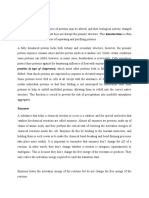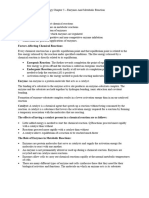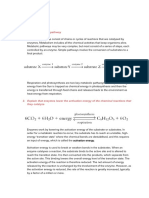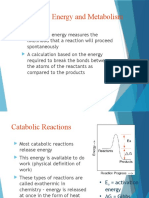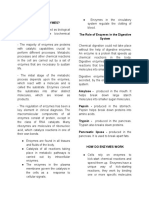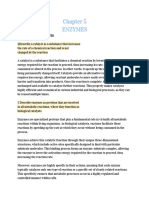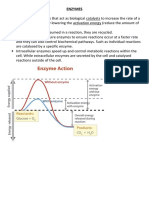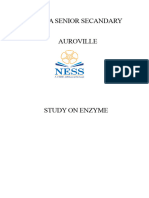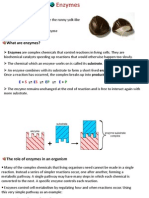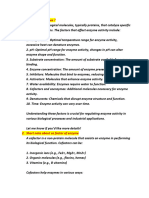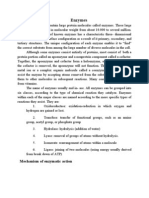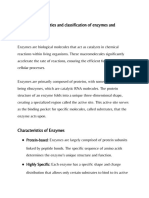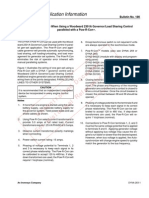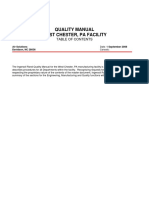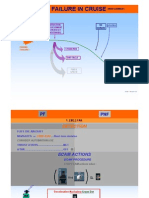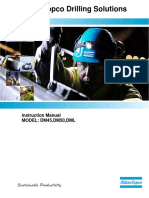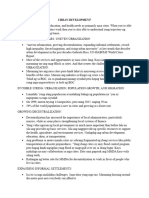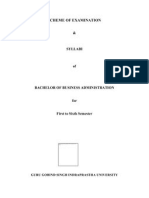Biology - MYP 2 - 15 Nov
Biology - MYP 2 - 15 Nov
Uploaded by
rishikk.pathakCopyright:
Available Formats
Biology - MYP 2 - 15 Nov
Biology - MYP 2 - 15 Nov
Uploaded by
rishikk.pathakCopyright
Available Formats
Share this document
Did you find this document useful?
Is this content inappropriate?
Copyright:
Available Formats
Biology - MYP 2 - 15 Nov
Biology - MYP 2 - 15 Nov
Uploaded by
rishikk.pathakCopyright:
Available Formats
MYP Year 2 – Notes (Biology)
Criteria A
Command Terms -Definition
Analyse -Break down in order to bring out the essential elements or structure. To identify parts
and relationships, and to interpret information to reach conclusions.
Apply- Use knowledge and understanding in response to a given situation or real circumstances
Describe -Give a detailed account or picture of a situation, event, pattern or process
Design- Produce a plan, simulation or model
Discuss- Offer a considered and balanced review that includes a range of arguments, factors or
hypotheses. Opinions or conclusions should be presented clearly and supported by appropriate
evidence
Outline- Give a brief account
Recall -Remember or recognize from prior learning experiences
Select -Choose from a list or group
State -Give a specific name, value or other brief answer without explanation or calculation
Suggest -Propose a solution, hypothesis or other possible answer
Summarize -Abstract a general theme or major points
Middle Years Programme | Indus International School, Pune | 2024-25
The Digestive System- Enzymes
Key points
Enzymes are:
o Catalysts that speed up the rate of a chemical reaction without being
changed or used up in the reaction
o Proteins
o Biological catalysts (biological because they are made in living cells,
catalysts because they speed up the rate of chemical reactions without being
changed)
o Necessary to all living organisms as they maintain reaction speeds of all
metabolic reactions (all the reactions that keep an organism alive) at a rate that
can sustain life
For example, if we did not produce digestive enzymes, it would take
around 2 - 3 weeks to digest one meal; with enzymes, it takes around 4
hours.
https://my.clevelandclinic.org/health/articles/21532-enzymes - Read this.
How do enzymes work?
Middle Years Programme | Indus International School, Pune | 2024-25
Enzymes are specific to one particular substrate (molecule/s that get broken down or
joined together in the reaction) as the enzyme is a complementary shape to the
substrate
The product is made from the substrate(s) and is released.
Mechanism of enzyme action
In most chemical reactions, an energy barrier exists that must be overcome for the
reaction to occur. This barrier prevents complex molecules such as proteins and
nucleic acids from spontaneously degrading, and so is necessary for the preservation
of life. When metabolic changes are required in a cell, however, certain of these
complex molecules must be broken down, and this energy barrier must be
surmounted. Heat could provide the additional needed energy (called activation
energy), but the rise in temperature would kill the cell. The alternative is to lower the
activation energy level through the use of a catalyst. This is the role that enzymes
play. They react with the substrate to form an intermediate complex—a “transition
state”—that requires less energy for the reaction to proceed. The unstable
intermediate compound quickly breaks down to form reaction products, and the
unchanged enzyme is free to react with other substrate molecules.
Only a certain region of the enzyme, called the active site, binds to the substrate. The
active site is a groove or pocket formed by the folding pattern of the protein. This
three-dimensional structure, together with the chemical and electrical properties of the
amino acids and cofactors within the active site, permits only a particular substrate to
bind to the site, thus determining the enzyme’s specificity.
Enzyme synthesis and activity also are influenced by genetic control and distribution
in a cell. Some enzymes are not produced by certain cells, and others are formed only
Middle Years Programme | Indus International School, Pune | 2024-25
when required. Enzymes are not always found uniformly within a cell; often they are
compartmentalized in the nucleus, on the cell membrane, or in subcellular structures.
The rates of enzyme synthesis and activity are further influenced by hormones,
neurosecretions, and other chemicals that affect the cell’s internal environment.
Factors affecting enzyme activity
Because enzymes are not consumed in the reactions they catalyze and can be used
over and over again, only a very small quantity of an enzyme is needed to catalyze a
reaction. A typical enzyme molecule can convert 1,000 substrate molecules per
second. The rate of an enzymatic reaction increases with increased substrate
concentration, reaching maximum velocity when all active sites of the enzyme
molecules are engaged. The enzyme is then said to be saturated, the rate of the
reaction being determined by the speed at which the active sites can convert substrate
to product.
Enzyme activity can be inhibited in various ways. Competitive inhibition occurs when
molecules very similar to the substrate molecules bind to the active site and prevent
binding of the actual substrate. Penicillin, for example, is a competitive inhibitor that
blocks the active site of an enzyme that many bacteria use to construct their cell walls.
Noncompetitive inhibition occurs when an inhibitor binds to the enzyme at a location
other than the active site. In some cases of noncompetitive inhibition, the inhibitor is
thought to bind to the enzyme in such a way as to physically block the normal active
site. In other instances, the binding of the inhibitor is believed to change the shape of
the enzyme molecule, thereby deforming its active site and preventing it from reacting
with its substrate. This latter type of noncompetitive inhibition is called allosteric
inhibition; the place where the inhibitor binds to the enzyme is called the allosteric
site. Frequently, an end-product of a metabolic pathway serves as an allosteric
inhibitor on an earlier enzyme of the pathway. This inhibition of an enzyme by a
product of its pathway is a form of negative feedback.
Allosteric control can involve stimulation of enzyme action as well as inhibition. An
activator molecule can be bound to an allosteric site and induce a reaction at the
active site by changing its shape to fit a substrate that could not induce the change by
itself. Common activators include hormones and the products of earlier enzymatic
reactions. Allosteric stimulation and inhibition allow production of energy and
materials by the cell when they are needed and inhibit production when the supply is
adequate.
Middle Years Programme | Indus International School, Pune | 2024-25
Test questions
What are enzymes and what do they do?
Answer: Enzymes are special proteins that act as biological catalysts. They speed up chemical
reactions in our bodies without being used up themselves.
Explain the "lock and key" model of enzyme action.
Answer: The "lock and key" model describes how enzymes work. The enzyme (lock) has a
specific shape that only fits a particular molecule (key), called the substrate. The substrate
binds to the active site of the enzyme, forming an enzyme-substrate complex. This complex
allows the reaction to take place more quickly, and the products are released.
How do changes in temperature and pH affect enzyme activity?
Answer: Enzymes have an optimal temperature and pH at which they work best. If the
temperature or pH is too high or too low, the enzyme's
shape can change, making it less effective or even stopping it from working altogether. This
is because the shape of the active site is crucial for the substrate to bind.
Bibliography
https://www.britannica.com/science/enzyme/Factors-affecting-enzyme-activity
https://www.osmosis.org/learn/Enzyme_function
https://my.clevelandclinic.org/health/articles/21532-enzymes
Brainly.in
Middle Years Programme | Indus International School, Pune | 2024-25
You might also like
- CH 17Document55 pagesCH 17Aljebre Mohmed67% (3)
- Tier-2 Audit ChecksheetDocument17 pagesTier-2 Audit ChecksheetSilambarasan K100% (1)
- Biology ProjectDocument41 pagesBiology ProjectGanesan Siva67% (12)
- Enzyme NotesDocument4 pagesEnzyme NotesPreethaNo ratings yet
- Protein Denaturation: EnzymesDocument7 pagesProtein Denaturation: EnzymescharlesNo ratings yet
- GCE AS Biology 3 ENZYME NoteDocument11 pagesGCE AS Biology 3 ENZYME Notengnicole090607No ratings yet
- Week 6 EnzymessDocument49 pagesWeek 6 EnzymessRechell Mae DaclesNo ratings yet
- Enzymes and The Active SiteDocument23 pagesEnzymes and The Active SiteLaura GambaNo ratings yet
- EnzymesDocument3 pagesEnzymessashi bNo ratings yet
- BIOLOGY Chapter 3 - EnzymesDocument5 pagesBIOLOGY Chapter 3 - Enzymeschelsea AlexandriaNo ratings yet
- Metabolism (HL)Document26 pagesMetabolism (HL)Sapreen KaurNo ratings yet
- Enzymes (As Biology)Document42 pagesEnzymes (As Biology)Muhtasim FarhanNo ratings yet
- Enzyme ChemistryDocument9 pagesEnzyme ChemistryVictor OmoloNo ratings yet
- 12 - EnzymeDocument2 pages12 - EnzymeEnriko PalicpicNo ratings yet
- Lesson #8 - EnzymesDocument29 pagesLesson #8 - EnzymesMaya AwadNo ratings yet
- 5.2 EnzymesDocument22 pages5.2 EnzymesShehbaaz SinghNo ratings yet
- Gen Bio 1 2nd Quarter ModularDocument8 pagesGen Bio 1 2nd Quarter ModularAriane NicoleNo ratings yet
- Aondonengen, s. Michael- Mcb 813 AssignmentDocument25 pagesAondonengen, s. Michael- Mcb 813 Assignmentaondonengenmichael430No ratings yet
- EnzymesDocument5 pagesEnzymeseyosiyas tekleweyinNo ratings yet
- Enzymes ...Document13 pagesEnzymes ...Glen MangaliNo ratings yet
- Enzymes 1Document6 pagesEnzymes 1zarszNo ratings yet
- Chap 5 Bio IgcseDocument7 pagesChap 5 Bio Igcseananya.arumugarajanNo ratings yet
- AP BIO Febraury Break With AnswersDocument12 pagesAP BIO Febraury Break With AnswersMehak BectorNo ratings yet
- Lecture On EnzymesDocument26 pagesLecture On EnzymesDAVIE MATIASNo ratings yet
- Jessica Lee Enzyme LabDocument15 pagesJessica Lee Enzyme LabAshalee JonesNo ratings yet
- EnzymesDocument6 pagesEnzymesSarah Farhah2000100% (1)
- Activity 8 - EnzymesDocument3 pagesActivity 8 - Enzymesahmadjumli27No ratings yet
- EnzymesDocument20 pagesEnzymesLove LovelyNo ratings yet
- Final Study On EnzymeDocument9 pagesFinal Study On Enzymerosariopraveen007No ratings yet
- 4-C1.1 Enzymes and MetabolismDocument42 pages4-C1.1 Enzymes and Metabolismmakaya02No ratings yet
- EnzymesDocument22 pagesEnzymesMaira ButtNo ratings yet
- Lasaca Report (Enzymes)Document43 pagesLasaca Report (Enzymes)MaryAnn LasacaNo ratings yet
- ENZYMEDocument4 pagesENZYMESawera dostNo ratings yet
- MT120 Lecture 3Document23 pagesMT120 Lecture 3Rae Stephen CaadlaonNo ratings yet
- What Are Enzymes?: E E E EDocument15 pagesWhat Are Enzymes?: E E E EFarhana MuradNo ratings yet
- Enzyme, A Substance That Acts As ADocument5 pagesEnzyme, A Substance That Acts As Amuhammad aslamNo ratings yet
- Enzymes: Principles of BiologyDocument18 pagesEnzymes: Principles of BiologyNaskar SouvikNo ratings yet
- Factors of EnzymesDocument13 pagesFactors of Enzymeshowto7470No ratings yet
- L8 EnzymesDocument26 pagesL8 Enzymesayaanali.voraNo ratings yet
- VIII Biology HO 5Document6 pagesVIII Biology HO 5aditiroy201208No ratings yet
- Enzymes: Mechanism of Enzymatic ActionDocument5 pagesEnzymes: Mechanism of Enzymatic ActionMoon PhạmNo ratings yet
- Unit 2 - Enzymes and MetabolismDocument20 pagesUnit 2 - Enzymes and Metabolismsidhushaan3No ratings yet
- En ZymologyDocument7 pagesEn Zymologyhowto7470No ratings yet
- EnzymesDocument10 pagesEnzymesdiformeddinoNo ratings yet
- Chapter-6.1-Enzymes-and-metabolism-2Document6 pagesChapter-6.1-Enzymes-and-metabolism-2ebitnercristineNo ratings yet
- Enzymes New1Document19 pagesEnzymes New1AHMAD NAWAZNo ratings yet
- 4 - EnzymesDocument31 pages4 - EnzymescheckmateNo ratings yet
- Enzymes: Enzymes Homeostasis Activation EnergyDocument6 pagesEnzymes: Enzymes Homeostasis Activation EnergyGowthami MarreddyNo ratings yet
- The Nature, Properties and Classifiication Ofi Enzymes and CofiactorsDocument24 pagesThe Nature, Properties and Classifiication Ofi Enzymes and CofiactorsuagboladeNo ratings yet
- Enzymes: Biology Lecture Prepared By: Waleed Zahoor Team Roshni Step-Up PakistanDocument11 pagesEnzymes: Biology Lecture Prepared By: Waleed Zahoor Team Roshni Step-Up PakistanRabia KhalilNo ratings yet
- Enzyme: Enzymes AreDocument11 pagesEnzyme: Enzymes ArePiyush BhallaNo ratings yet
- Enzymes:: Commented (1) : Im Going To Add The Notes From TheDocument5 pagesEnzymes:: Commented (1) : Im Going To Add The Notes From TheSarahNo ratings yet
- Lesson 1 EnzymesDocument7 pagesLesson 1 Enzymes193areeshakhanNo ratings yet
- Chapter 02 EnzymesDocument8 pagesChapter 02 Enzymesmiraniwaqar16No ratings yet
- What Are Enzymes?: "Enzymes Can Be Defined As Biological Polymers That Catalyze Biochemical Reactions."Document11 pagesWhat Are Enzymes?: "Enzymes Can Be Defined As Biological Polymers That Catalyze Biochemical Reactions."punitchauhanaltNo ratings yet
- Enzymology: Theresa May Chin TanDocument20 pagesEnzymology: Theresa May Chin TanVejerla PriyankaNo ratings yet
- Bio Investigatory (Study of Enzymes) - 3Document18 pagesBio Investigatory (Study of Enzymes) - 3Deepa Singh0% (1)
- Enzymes NotesDocument5 pagesEnzymes NotesFrancis ChegeNo ratings yet
- MC 2 Activity 7Document2 pagesMC 2 Activity 7mangubatreynald17No ratings yet
- A-level Biology Revision: Cheeky Revision ShortcutsFrom EverandA-level Biology Revision: Cheeky Revision ShortcutsRating: 5 out of 5 stars5/5 (5)
- 18KDocument4 pages18KhumcataNo ratings yet
- Caixa Bank CommentsDocument2 pagesCaixa Bank CommentsEsther Ruiz CaboNo ratings yet
- H. Ratio and Similar ShapesDocument12 pagesH. Ratio and Similar ShapesDaSubirNo ratings yet
- Gabion Catalog: Samafe International, S.ADocument4 pagesGabion Catalog: Samafe International, S.Arsiqueirasantos5711No ratings yet
- Project On Watershed ManagementDocument59 pagesProject On Watershed Managementsaurabhd70100% (2)
- Tle Acp10-Q2-W1-Las 4Document2 pagesTle Acp10-Q2-W1-Las 4Ban VanNo ratings yet
- Rguhs Dissertation List 2012Document8 pagesRguhs Dissertation List 2012PayForAPaperCanada50% (2)
- NEGOTIABLE INSTRUMENT LAW-NotesDocument5 pagesNEGOTIABLE INSTRUMENT LAW-NotesGhrace Segundo CocalNo ratings yet
- Manual Controle de Qualidade PDFDocument7 pagesManual Controle de Qualidade PDFRogerio Nunes MarinhoNo ratings yet
- The Effects of Music On Consumer Behaviour in A Fine Dining Restaurant 2012Document98 pagesThe Effects of Music On Consumer Behaviour in A Fine Dining Restaurant 2012Ilia ZolasNo ratings yet
- A320-Engine Failure (Damage)Document10 pagesA320-Engine Failure (Damage)tugayyoung100% (2)
- Manual de Instrucción y Mtto DM 45Document810 pagesManual de Instrucción y Mtto DM 45marco gonzalezNo ratings yet
- Automatic Reverse Braking System: Ketan Meshram, Manish Pawar, Rohan Murkute, Jayesh MahajanDocument3 pagesAutomatic Reverse Braking System: Ketan Meshram, Manish Pawar, Rohan Murkute, Jayesh Mahajanjayesh mahajanNo ratings yet
- Do Stronger Intellectual Property Rights Increase Innovation?Document13 pagesDo Stronger Intellectual Property Rights Increase Innovation?andreeaNo ratings yet
- MSC New FormatDocument3 pagesMSC New FormatSamnan KhaledNo ratings yet
- Job Description (Bharti Airtel)Document2 pagesJob Description (Bharti Airtel)asmitatrehan24No ratings yet
- Design and Simulation of Automatic Phase Selector and Changeover Switch For 3-Phase SupplyDocument8 pagesDesign and Simulation of Automatic Phase Selector and Changeover Switch For 3-Phase SupplyNovelty JournalsNo ratings yet
- CDM 2018Document43 pagesCDM 2018robert kimengwaNo ratings yet
- NE-BMSI Feedback Survey Form Cupino 230428 213750Document4 pagesNE-BMSI Feedback Survey Form Cupino 230428 213750Rafaela GonzalezNo ratings yet
- A Glossary of Lean TermsDocument5 pagesA Glossary of Lean TermsDipak Kumar PatelNo ratings yet
- Rate of InterestpptDocument14 pagesRate of InterestpptAppan Kandala VasudevacharyNo ratings yet
- Urban DevelopmentDocument3 pagesUrban DevelopmentRivera, Erica HazelNo ratings yet
- Petunjuk DGT Per 25 PJ 2018Document2 pagesPetunjuk DGT Per 25 PJ 2018RJF HsbnNo ratings yet
- Bba SyllabusDocument76 pagesBba Syllabusprime0000No ratings yet
- Contractor's Community (REHDA)Document7 pagesContractor's Community (REHDA)Hazim ZulkiifliNo ratings yet
- Asian Regionalism: The Contemporary WorldDocument31 pagesAsian Regionalism: The Contemporary WorldDarren Ramon AvestruzNo ratings yet
- Visual public relations strategic communication beyond text 1st Edition Collister all chapter instant downloadDocument55 pagesVisual public relations strategic communication beyond text 1st Edition Collister all chapter instant downloadokomfohasboo100% (2)
- Nidha HRMDocument20 pagesNidha HRMNidha IsmailNo ratings yet




